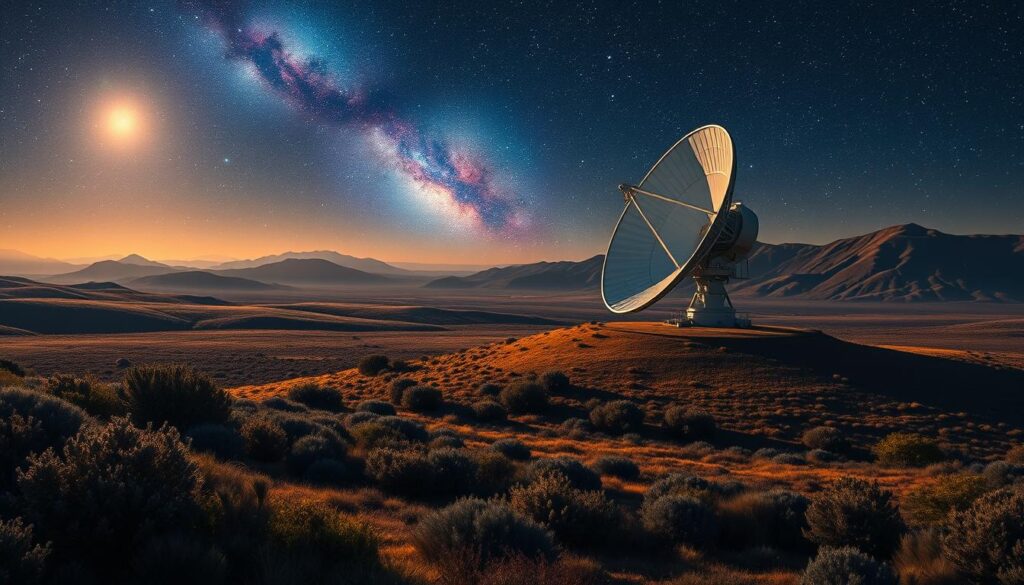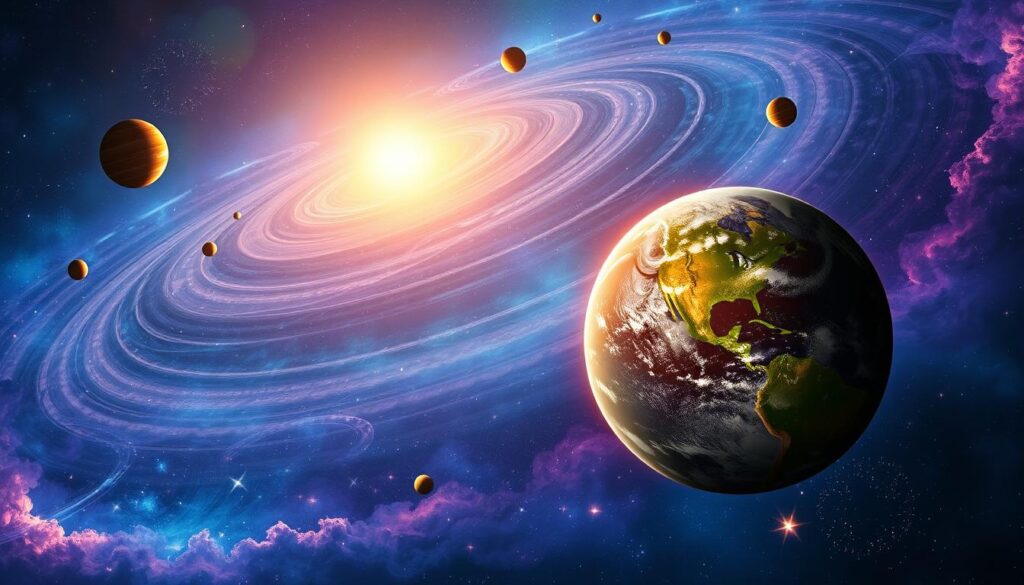“As an Amazon Associate I earn from qualifying purchases.” .
When we look up at the stars, we feel a spark of wonder. The stars and galaxies seem to call us, making us curious about what lies beyond our world. Exploring deep space is not just a science project. It’s a journey that touches our deepest desires to explore, understand, and go beyond what we know.
Our search for the universe’s secrets has taken us on an amazing journey. From our first steps into space to sending probes to the edge of our solar system, we’ve learned a lot. But with every new find, we realize there’s still so much to learn.
Exploring deep space is not just about science. It’s about the big questions it raises about our place in the universe. By looking deeper into space, we’re seeing the universe’s past. We’re witnessing the Big Bang’s aftermath and maybe finding clues about our universe’s start and end.
What was once just in science fiction, interstellar travel, is now a real goal. Our technology keeps getting better, bringing us closer to sending humans beyond our solar system. The discoveries we could make in these new places could change our understanding of the universe. They could change how we see physics, biology, and even life itself.
Key Takeaways
- Deep space begins 2 million km from Earth’s surface
- Voyager 1 and 2 have entered interstellar space
- Over 6,500 satellites orbit Earth, aiding space research
- The Milky Way is about 100,000 light-years wide
- Space exploration drives technological innovation
- International cooperation is crucial for deep space missions
- Space studies programs prepare future explorers and scientists
Unveiling the Mysteries of Deep Space
Deep space is full of wonders that call to us. It’s the vast area outside our solar system, where amazing things happen on a huge scale. We want to explore it because we’re curious about our spot in the universe.
Defining Deep Space: Beyond Our Solar System
Deep space is everything outside our solar system. Space probes go there to find out about distant stars and planets. The Orion Nebula is one place we can see that shows us the vastness of space.
The Allure of the Unknown: Why We Explore
We explore deep space to understand where we come from and where we might go. This has led to big discoveries about the universe. For example, did you know dark matter is about 27% of the universe but we don’t know much about it?
Historical Milestones in Deep Space Exploration
We’ve made big steps in space exploration, from sending radio signals into space to launching advanced space probes. These missions have changed how we see the universe and have opened doors for more exploration.
| Year | Milestone | Impact |
|---|---|---|
| 1957 | Launch of Sputnik 1 | First artificial satellite in Earth orbit |
| 1977 | Launch of Voyager 1 & 2 | First spacecraft to enter interstellar space |
| 1990 | Hubble Space Telescope | Revolutionary deep space imaging |
| 2025 | Gateway Lunar space station | Planned orbital outpost around the Moon |
These big moments in deep space exploration have changed how we see the universe. They keep pushing us to learn more about what’s beyond Earth.
The Deep Space Network: Our Eyes and Ears in the Cosmos
The Deep Space Network (DSN) is like our cosmic lifeline. It lets us see and hear from far-off space. NASA’s Jet Propulsion Laboratory runs this key system. Space Telescopes and other space tools use it to send us their big findings.
The DSN has three main spots around the world: Goldstone in California, Madrid in Spain, and Canberra in Australia. These places help keep in touch with spacecraft everywhere in our solar system or beyond.

The DSN is amazing. Its big dishes, up to 70 meters wide, can pick up signals as tiny as a billionth of a billionth of a watt. That’s like hearing a whisper from a huge distance!
“The Deep Space Network is the silent hero behind our greatest Astronomical Discoveries. It’s the thread that connects us to the mysteries of the cosmos.”
The DSN uses top technology to communicate over vast distances. It uses super-cooled amplifiers and special coding to make weak signals clear. This lets us control rovers on other planets and get data from probes at the solar system’s edge.
As we explore space more, the DSN is getting better. Scientists are working on an “Interplanetary Internet.” This new network will change how we do space missions and make new discoveries.
Voyager Missions: Pioneers of Interstellar Space
The Voyager missions are true pioneers in interstellar travel. Launched in 1977, these twin probes have greatly expanded our cosmic knowledge.
Voyager 1: First to Enter Interstellar Space
Voyager 1 made history on August 25, 2012, by entering interstellar space. It’s now 162 AU from Earth, moving at 61,198 kilometers per hour.
Voyager 2: Following its Twin into the Unknown
Voyager 2 followed its twin into interstellar space on November 4, 2018. It’s 136.627 AU from Earth, moving at 55,347 kilometers per hour. During its journey, it discovered 11 new moons and two rings around Uranus, plus six small moons and rings around Neptune.
Continuing Legacy: Data from the Edge of Our Solar System
These probes send back crucial data from interstellar space. They carry 11 scientific instruments and a golden record with Earth’s sounds and images. Despite losing power, a new plan aims to keep them going until 2024. This ensures their legacy as humanity’s farthest reach into space lasts.
| Spacecraft | Interstellar Entry Date | Distance from Earth (May 2024) | Speed |
|---|---|---|---|
| Voyager 1 | August 25, 2012 | 162 AU | 61,198 km/h |
| Voyager 2 | November 4, 2018 | 136.627 AU | 55,347 km/h |
Cutting-Edge Technologies for Deep Space Exploration
We’re stepping into a new era of deep space exploration, thanks to groundbreaking technologies. Space telescopes and probes lead this change, expanding our cosmic knowledge.
The James Webb Space Telescope is a huge leap forward, 1.5 million kilometers from Earth. It lets us see distant galaxies and planets with amazing clarity.
Probes like the Perseverance Rover are exploring Mars, looking for signs of life. The Sample Return Mission will bring back Martian samples, possibly revealing secrets of the planet.
NASA’s Deep Space Optical Communications (DSOC) system is changing how we send data from space. It could make sending information 10 to 100 times faster, making space communication more efficient.
New propulsion systems are being developed too. The Psyche mission uses solar electric propulsion to explore a metal asteroid. This could lead to faster travel in space.
“We’re on the cusp of a new age in space exploration, where cutting-edge technologies are turning science fiction into reality.”
These new technologies in space telescopes, probes, and communication will be our tools in deep space. They will be our eyes, ears, and voice in the vast universe.
Exoplanets: Discovering New Worlds
The search for exoplanets has changed how we see the universe. These distant worlds orbit stars outside our solar system. They are some of the most thrilling discoveries in astronomy. Exploring exoplanets has opened new areas in astrobiology, bringing hope for finding life beyond Earth.
Methods of Exoplanet Detection
Astronomers use different ways to find these distant bodies. The main methods are:
- Transit Photometry: This method spots exoplanets by noticing how a star dims when a planet passes in front of it.
- Radial Velocity: It measures how a star moves because of a planet’s gravity pulling on it.
Thanks to these methods, thousands of exoplanets have been found. They range from hot Jupiters to super-Earths. The new tech in space travel has helped a lot in these discoveries.
Promising Candidates for Extraterrestrial Life
We haven’t found alien life, but some exoplanets look good for it. About 50 exoplanets might have conditions right for life. These planets are in their star’s ‘Goldilocks zone’, which could support life as we know it.

Future Missions to Study Distant Worlds
The future of studying exoplanets looks bright. NASA’s Transiting Exoplanet Survey Satellite is making new discoveries. In the last decade, we’ve seen a 200% increase in finding exoplanets.
| Exoplanet Characteristic | Percentage |
|---|---|
| Discovered beyond our galaxy | 30% |
| With rings similar to Saturn | 10% |
| In single planetary systems | 45% |
| In binary planetary systems | 30% |
| In multiple planetary systems | 25% |
As we keep exploring, we get closer to answering a big question: Are we alone in the universe?
Celestial Mapping: Charting the Cosmic Landscape
Celestial mapping has evolved a lot since ancient times. Now, we use advanced technology to map the cosmos. These maps help us grasp the universe’s layout and guide space missions into the unknown.
The NASA Scientific Visualization Studio was started in 1990. It has about 15 experts in astronomy and 3D modeling. Since 2001, they’ve been sharing their work with the public.
The Gaia mission is a big project in celestial mapping. It’s a space telescope making a detailed 3D map of our galaxy. It’s like Google Maps for the Milky Way, helping us navigate space.
Celestial mapping isn’t just for scientists. It also inspires products like MoonPlate, which shows the moon’s surface on your table. Over 30,000 customers worldwide have bought space art from Astrography, showing how much people love the cosmos.
“The Art & the Cosmic Connection program uses art to teach K-12 students about the solar system, making celestial mapping accessible to all ages.”
As we keep mapping the cosmos, we make new discoveries. Celestial mapping helps us find exoplanets and understand dark matter. It’s key to unlocking the universe’s secrets.
The Search for Extraterrestrial Intelligence (SETI)
We’re on a quest to find Extraterrestrial Life. Space Telescopes scan the cosmos, searching for signs of alien civilizations. This exciting hunt has captured our imagination for decades.
Radio Telescope Arrays and the Hunt for Alien Signals
Radio telescope arrays are our ears to the universe. They listen for potential alien broadcasts amid Cosmic Phenomena. In 2015, the Breakthrough Listen Project invested $100 million over 10 years to detect signals from nearby stars.
The search has yielded intriguing results. In 1977, the “Wow!” signal sparked excitement as a promising radio transmission from space. More recently, in May 2023, a coded radio signal from Mars was detected by Earth’s radio telescopes.
The Fermi Paradox: Where Is Everybody?
Despite our efforts, we haven’t found definitive proof of alien life. This puzzle is known as the Fermi Paradox. It questions why we haven’t encountered extraterrestrials if the universe is teeming with life.
“The universe is a pretty big place. If it’s just us, seems like an awful waste of space.” – Carl Sagan
Ethical Considerations in Contacting Alien Civilizations
As we explore the wonders of space, we must consider the ethics of contacting aliens. Some scientists warn of potential risks. Others argue for proactive communication. The debate continues, highlighting the need for global consensus before reaching out to the stars.
| SETI Milestone | Year | Significance |
|---|---|---|
| Big Ear Program | 1950s | First continuous SETI program |
| Wow! Signal | 1977 | Promising radio signal detected |
| SETI@home | 1999-2020 | 5.2 million participants donated computing power |
| Breakthrough Listen | 2015 | $100 million investment in signal detection |
Deep Space Exploration: Challenges and Solutions
Exploring deep space brings us up against tough challenges. These challenges test our creativity and push us to think differently. For example, the Mars Curiosity rover cost almost $200 million to send into space. This shows how much we need to spend to explore the cosmos.
The space around us is full of hurdles. There are 17,000 objects orbiting Earth, moving at speeds over 17,500 mph. This is a big problem because of space debris. To fight radiation risks, scientists are looking at new ways to build spacecraft, like using plastics to reduce radiation.
Keeping life going in space is a big challenge. Engineers are working on new materials that help plants grow in space. They’re also growing special plants, like a small plum tree, for gardening in space. And, they’re finding ways to recycle water using special bacteria to keep supplies up during long missions.
Exploring space is hard on our bodies because of weightlessness. It can cause bones and muscles to weaken. But, scientists are working hard to solve these problems. They’re making progress, which will help us go further into space and learn more about the universe.
FAQ
What is deep space?
Why do we explore deep space?
What is the Deep Space Network (DSN)?
What are the Voyager missions?
What cutting-edge technologies are used for deep space exploration?
What are exoplanets, and how are they detected?
What is celestial mapping, and why is it important?
What is SETI, and what is the Fermi Paradox?
What are some challenges faced in deep space exploration?
“As an Amazon Associate I earn from qualifying purchases.” .



